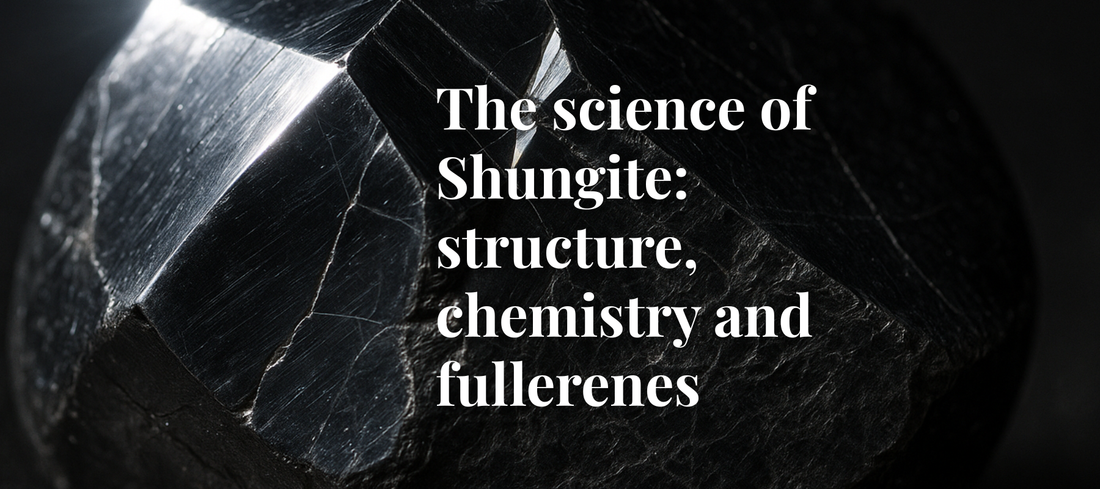
The Science Of Shungite - Structure, Chemistry and Fullerenes
Share
Shungite is unlike any other mineral on Earth. Its remarkable carbon composition and unique molecular structure have captured the attention of researchers and wellness seekers alike. This ancient stone bridges the gap between science and spirituality, combining natural formation with extraordinary physical and energetic properties.
In this article, we explore what makes Shungite scientifically exceptional - from its chemistry and conductivity to the role of fullerenes and ongoing research into its uses.
Chemical Composition Of Shungite
Shungite is composed primarily of carbon, silicon, oxygen, hydrogen, and trace elements such as iron, aluminium, and magnesium. What sets it apart from other carbon-based minerals is the presence of natural fullerenes - hollow, spherical carbon molecules rarely found in nature.
The carbon content varies depending on the type of Shungite:
- Elite (Type I): up to 98 percent carbon
- Regular (Type II): around 60 to 70 percent carbon
- Gray (Type III): 30 to 50 percent carbon
This high carbon density contributes to Shungite’s conductivity, durability, and ability to interact with electromagnetic energy, making it both scientifically fascinating and energetically potent.

Physical and Structural Properties
Porosity and purification potential
Shungite’s internal structure is highly porous, meaning it contains tiny openings that allow water and air to pass through. This natural filtration property is why Shungite has been used for centuries to purify water. Its pores trap impurities and support a natural mineral exchange that enriches the water.
Modern studies confirm that shungite can help reduce bacteria and organic contaminants, though it should always be used responsibly as part of a balanced wellness routine.
Electrical conductivity
One of Shungite’s most studied features is its electrical conductivity. Due to its carbon-rich composition, Shungite conducts electricity like metal, which is unusual for a natural stone. This property is one reason it is believed to neutralise or harmonise electromagnetic frequencies (EMFs).
In industrial applications, Shungite’s conductivity has led to interest in its use as a component in paints, coatings, and composite materials designed to reduce static and electromagnetic interference.
Fullerenes and Why They Matter
Fullerenes are microscopic carbon molecules shaped like hollow spheres, resembling a soccer ball at the molecular level. Discovered in 1985, fullerenes earned their discoverers the Nobel Prize in Chemistry.
Shungite is the only known natural mineral on Earth that contains fullerenes in significant amounts. These molecules are of great interest because of their antioxidant potential. In laboratory settings, fullerenes have been shown to neutralise free radicals, reduce oxidative stress, and support cellular protection.
In Shungite water, small amounts of fullerenes may dissolve, potentially enriching the water with antioxidant qualities. While research continues, the natural presence of fullerenes is one of the main reasons shungite is considered both a scientific and spiritual marvel.
Studies and Applications Of Shungite
Scientific and industrial uses
Beyond its metaphysical appeal, Shungite has attracted attention in materials science. Researchers are exploring its use in:
- Water purification systems for its antibacterial and filtering properties
- Protective coatings that reduce radiation and electrical conductivity
- Nanotechnology for carbon-based composites and catalysts
- Cosmetics as a natural antioxidant and purifying agent
These studies highlight how shungite’s ancient carbon structure can serve modern technological innovation.
Wellness and energy research
In holistic wellness, Shungite is valued for its grounding and balancing qualities. Its conductive nature is thought to help harmonise the energy of a space, promoting stability and a sense of calm. Many people find that keeping Shungite nearby enhances focus, supports restful sleep, and creates a more peaceful atmosphere in environments with high electromagnetic activity.
Whether used in personal spaces, meditation areas, or workplaces, Shungite continues to be recognised for the sense of balance and protection it brings to modern living.
Ongoing Research and Modern Interest
Interest in Shungite continues to grow as both science and wellness communities explore its potential. Studies are ongoing into how its fullerenes, conductivity, and carbon structure can be applied in fields such as renewable energy, medicine, and environmental sustainability.
As research evolves, Shungite stands as a rare example of nature’s complexity - a mineral that connects ancient geology with modern discovery.
To understand where this extraordinary stone comes from and the different forms it takes, read our previous article: What is Shungite - origins, types and grades.
For practical guidance on how shungite interacts with electromagnetic frequencies, continue to our next article: Shungite and EMF protection - myths, science and misconceptions.
